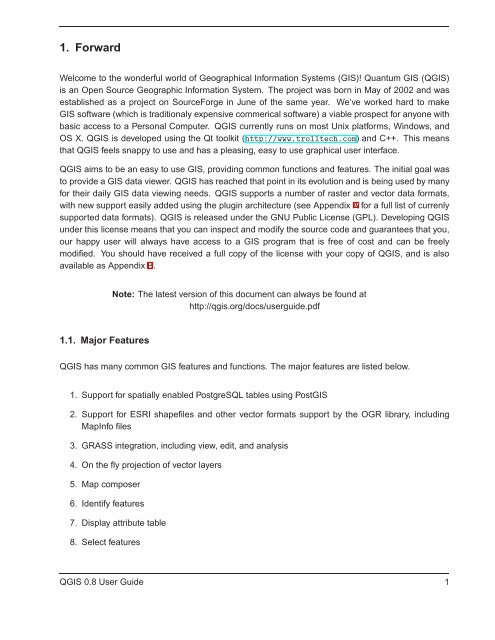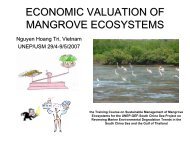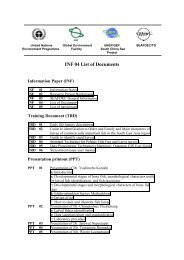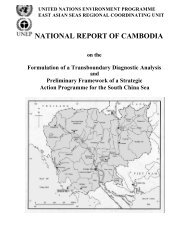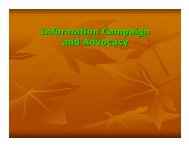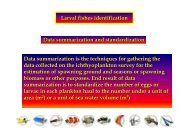TRD 05: Data Presentation techniques (Mapping) Quantum GIS ...
TRD 05: Data Presentation techniques (Mapping) Quantum GIS ...
TRD 05: Data Presentation techniques (Mapping) Quantum GIS ...
Create successful ePaper yourself
Turn your PDF publications into a flip-book with our unique Google optimized e-Paper software.
1. Forward<br />
Welcome to the wonderful world of Geographical Information Systems (<strong>GIS</strong>)! <strong>Quantum</strong> <strong>GIS</strong> (Q<strong>GIS</strong>)<br />
is an Open Source Geographic Information System. The project was born in May of 2002 and was<br />
established as a project on SourceForge in June of the same year. We’ve worked hard to make<br />
<strong>GIS</strong> software (which is traditionaly expensive commerical software) a viable prospect for anyone with<br />
basic access to a Personal Computer. Q<strong>GIS</strong> currently runs on most Unix platforms, Windows, and<br />
OS X. Q<strong>GIS</strong> is developed using the Qt toolkit (http://www.trolltech.com) and C++. This means<br />
that Q<strong>GIS</strong> feels snappy to use and has a pleasing, easy to use graphical user interface.<br />
Q<strong>GIS</strong> aims to be an easy to use <strong>GIS</strong>, providing common functions and features. The initial goal was<br />
to provide a <strong>GIS</strong> data viewer. Q<strong>GIS</strong> has reached that point in its evolution and is being used by many<br />
for their daily <strong>GIS</strong> data viewing needs. Q<strong>GIS</strong> supports a number of raster and vector data formats,<br />
with new support easily added using the plugin architecture (see Appendix A for a full list of currenly<br />
supported data formats). Q<strong>GIS</strong> is released under the GNU Public License (GPL). Developing Q<strong>GIS</strong><br />
under this license means that you can inspect and modify the source code and guarantees that you,<br />
our happy user will always have access to a <strong>GIS</strong> program that is free of cost and can be freely<br />
modified. You should have received a full copy of the license with your copy of Q<strong>GIS</strong>, and is also<br />
available as Appendix B.<br />
Note: The latest version of this document can always be found at<br />
http://qgis.org/docs/userguide.pdf<br />
1.1. Major Features<br />
Q<strong>GIS</strong> has many common <strong>GIS</strong> features and functions. The major features are listed below.<br />
1. Support for spatially enabled PostgreSQL tables using Post<strong>GIS</strong><br />
2. Support for ESRI shapefiles and other vector formats support by the OGR library, including<br />
MapInfo files<br />
3. GRASS integration, including view, edit, and analysis<br />
4. On the fly projection of vector layers<br />
5. Map composer<br />
6. Identify features<br />
7. Display attribute table<br />
8. Select features<br />
Q<strong>GIS</strong> 0.8 User Guide 1


